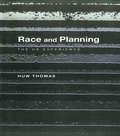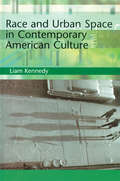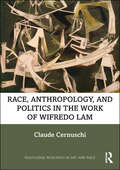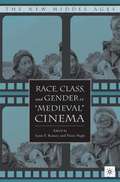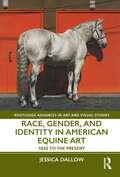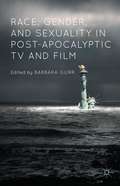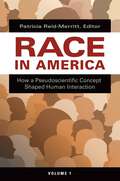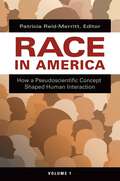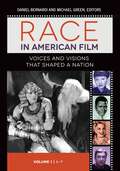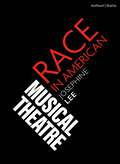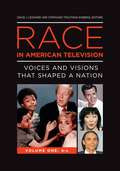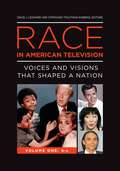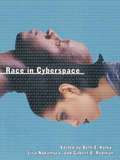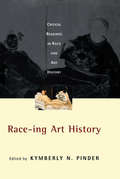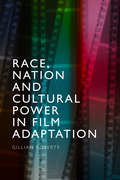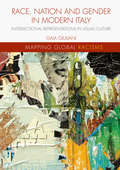- Table View
- List View
Race and Planning: The UK Experience
by Huw ThomasDrawing on a number of research studies of planning and urban policy, ace and Planning asks why racial equality has not been higher on professional and government agendas, and suggests strategies for those working on change. It considers key issues such as how planning activities might lead to more emphasis on the significance of racial equality; might currently it be unwittingly underpinning racial disadvantage? Alternatively, can planning help challenge racism and promote equal opportunities? The book's arguments are sensitive to the rapidly changing focus of the politics of race including: 'fortress Europe', Macpherson and modernism.
Race and Planning: The UK Experience
by Huw ThomasDrawing on a number of research studies of planning and urban policy, ace and Planning asks why racial equality has not been higher on professional and government agendas, and suggests strategies for those working on change. It considers key issues such as how planning activities might lead to more emphasis on the significance of racial equality; might currently it be unwittingly underpinning racial disadvantage? Alternatively, can planning help challenge racism and promote equal opportunities? The book's arguments are sensitive to the rapidly changing focus of the politics of race including: 'fortress Europe', Macpherson and modernism.
Race and Urban Space in American Culture
by Liam KennedyFirst published in 2000. Routledge is an imprint of Taylor & Francis, an informa company.
Race and Urban Space in American Culture (Tendencies: Identities, Texts, Cultures Ser.)
by Liam KennedyFirst published in 2000. Routledge is an imprint of Taylor & Francis, an informa company.
Race, Anthropology, and Politics in the Work of Wifredo Lam (Routledge Research in Art and Race)
by Claude CernuschiThis book reinterprets Wifredo Lam’s work with particular attention to its political implications, focusing on how these implications emerge from the artist’s critical engagement with 20th-century anthropology. Field work conducted in Cuba, including the witnessing of actual Afro-Cuban religious ritual ceremonies and information collected from informants, enhances the interpretive background against which we can construe the meanings of Lam's art. In the process, Claude Cernuschi argues that Lam hoped to fashion a new hybrid style to foster pride and dignity in the Afro-Cuban community, as well as counteract the acute racism of Cuban culture.
Race, Anthropology, and Politics in the Work of Wifredo Lam (Routledge Research in Art and Race)
by Claude CernuschiThis book reinterprets Wifredo Lam’s work with particular attention to its political implications, focusing on how these implications emerge from the artist’s critical engagement with 20th-century anthropology. Field work conducted in Cuba, including the witnessing of actual Afro-Cuban religious ritual ceremonies and information collected from informants, enhances the interpretive background against which we can construe the meanings of Lam's art. In the process, Claude Cernuschi argues that Lam hoped to fashion a new hybrid style to foster pride and dignity in the Afro-Cuban community, as well as counteract the acute racism of Cuban culture.
Race, Class, and Gender in "Medieval" Cinema (The New Middle Ages)
by L. Ramey T. PughThe medieval film genre is not, in general, concerned with constructing a historically accurate past, but much analysis nonetheless centers on highlighting anachronisms. This book aims to help scholars and aficionados of medieval film think about how the re-creation of an often mythical past performs important cultural work for modern directors and viewers. The essays in this collection demonstrate that directors intentionally insert modern preoccupations into a setting that would normally be considered incompatible with these concepts. The Middle Ages provide an imaginary space far enough removed from the present day to explore modern preoccupations with human identity.
Race, Gender, and Identity in American Equine Art: 1832 to the Present (Routledge Advances in Art and Visual Studies)
by Jessica DallowThis book traces an evolution of equine and equestrian art in the United States over the last two centuries to counter conventional understandings of subjects that are deeply enmeshed in the traditions of elite English and European culture. In focusing on the construction of identity in painting and photography—of Blacks, women, and the animals themselves involved in horseracing, rodeo, and horse show competition—it illuminates the strategic and varying roles visual artists have played in producing cultural understandings of human-animal relationships. As the first book to offer a history of American equine and equestrian imagery, it shrinks the chasm of literature on the subject and illustrates the significance of the genre to the history of American art. This book further connects American equine and equestrian art to historical, theoretical, and philosophical analyses of animals and attests to how the horse endures as a vital, meaningful subject within the art world as well as culture at large. This book will be of interest to scholars in art history, American art, gender studies, race and ethnic studies, and animal studies.
Race, Gender, and Identity in American Equine Art: 1832 to the Present (Routledge Advances in Art and Visual Studies)
by Jessica DallowThis book traces an evolution of equine and equestrian art in the United States over the last two centuries to counter conventional understandings of subjects that are deeply enmeshed in the traditions of elite English and European culture. In focusing on the construction of identity in painting and photography—of Blacks, women, and the animals themselves involved in horseracing, rodeo, and horse show competition—it illuminates the strategic and varying roles visual artists have played in producing cultural understandings of human-animal relationships. As the first book to offer a history of American equine and equestrian imagery, it shrinks the chasm of literature on the subject and illustrates the significance of the genre to the history of American art. This book further connects American equine and equestrian art to historical, theoretical, and philosophical analyses of animals and attests to how the horse endures as a vital, meaningful subject within the art world as well as culture at large. This book will be of interest to scholars in art history, American art, gender studies, race and ethnic studies, and animal studies.
Race, Gender, and Sexuality in Post-Apocalyptic TV and Film
by Barbara Gurr Brayton PolkaThis book offers analyses of the roles of race, gender, and sexuality in the post-apocalyptic visions of early twenty-first century film and television shows. Contributors examine the production, reproduction, and re-imagination of some of our most deeply held human ideals through sociological, anthropological, historical, and feminist approaches.
Race in America [2 volumes]: How a Pseudoscientific Concept Shaped Human Interaction [2 volumes]
by Patricia Reid-Merritt, EditorFocusing on the socially explosive concept of race and how it has affected human interactions, this work examines the social and scientific definitions of race, the implementation of racialized policies and practices, the historical and contemporary manifestations of the use of race in shaping social interactions within U.S. society and elsewhere, and where our notions of race will likely lead.More than a decade and a half into the 21st century, the term "race" remains one of the most emotionally charged words in the human language. While race can be defined as "a local geographic or global human population distinguished as a more or less distinct group by genetically transmitted physical characteristics," the concept of race can better be understood as a socially defined construct—a system of human classification that carries tremendous weight, yet is complex, confusing, contradictory, controversial, and imprecise. This collection of essays focuses on the socially explosive concept of race and how it has shaped human interactions across civilization. The contributed work examines the social and scientific definitions of race, the implementation of racialized policies and practices, and the historical and contemporary manifestations of the use of race in shaping social interactions (primarily) in the United States—a nation where the concept of race is further convoluted by the nation's extensive history of miscegenation as well as the continuous flow of immigrant groups from countries whose definitions of race, ethnicity, and culture remain fluid. Readers will gain insights into subjects such as how we as individuals define ourselves through concepts of race, how race affects social privilege, "color blindness" as an obstacle to social change, legal perspectives on race, racialization of the religious experience, and how the media perpetuates racial stereotypes.
Race in America [2 volumes]: How a Pseudoscientific Concept Shaped Human Interaction [2 volumes]
Focusing on the socially explosive concept of race and how it has affected human interactions, this work examines the social and scientific definitions of race, the implementation of racialized policies and practices, the historical and contemporary manifestations of the use of race in shaping social interactions within U.S. society and elsewhere, and where our notions of race will likely lead.More than a decade and a half into the 21st century, the term "race" remains one of the most emotionally charged words in the human language. While race can be defined as "a local geographic or global human population distinguished as a more or less distinct group by genetically transmitted physical characteristics," the concept of race can better be understood as a socially defined construct—a system of human classification that carries tremendous weight, yet is complex, confusing, contradictory, controversial, and imprecise. This collection of essays focuses on the socially explosive concept of race and how it has shaped human interactions across civilization. The contributed work examines the social and scientific definitions of race, the implementation of racialized policies and practices, and the historical and contemporary manifestations of the use of race in shaping social interactions (primarily) in the United States—a nation where the concept of race is further convoluted by the nation's extensive history of miscegenation as well as the continuous flow of immigrant groups from countries whose definitions of race, ethnicity, and culture remain fluid. Readers will gain insights into subjects such as how we as individuals define ourselves through concepts of race, how race affects social privilege, "color blindness" as an obstacle to social change, legal perspectives on race, racialization of the religious experience, and how the media perpetuates racial stereotypes.
Race in American Film [3 volumes]: Voices and Visions That Shaped a Nation [3 volumes]
by Daniel Bernardi and Michael Green, EditorsThis expansive three-volume set investigates racial representation in film, providing an authoritative cross-section of the most racially significant films, actors, directors, and movements in American cinematic history.Hollywood has always reflected current American cultural norms and ideas. As such, film provides a window into attitudes about race and ethnicity over the last century. This comprehensive set provides information on hundreds of films chosen based on scholarly consensus of their importance regarding the subject, examining aspects of race and ethnicity in American film through the historical context, themes, and people involved.This three-volume set highlights the most important films and artists of the era, identifying films, actors, or characterizations that were considered racist, were tremendously popular or hugely influential, attempted to be progressive, or some combination thereof. Readers will not only learn basic information about each subject but also be able to contextualize it culturally, historically, and in terms of its reception to understand what average moviegoers thought about the subject at the time of its popularity—and grasp how the subject is perceived now through the lens of history.
Race in American Film [3 volumes]: Voices and Visions That Shaped a Nation [3 volumes]
This expansive three-volume set investigates racial representation in film, providing an authoritative cross-section of the most racially significant films, actors, directors, and movements in American cinematic history.Hollywood has always reflected current American cultural norms and ideas. As such, film provides a window into attitudes about race and ethnicity over the last century. This comprehensive set provides information on hundreds of films chosen based on scholarly consensus of their importance regarding the subject, examining aspects of race and ethnicity in American film through the historical context, themes, and people involved.This three-volume set highlights the most important films and artists of the era, identifying films, actors, or characterizations that were considered racist, were tremendously popular or hugely influential, attempted to be progressive, or some combination thereof. Readers will not only learn basic information about each subject but also be able to contextualize it culturally, historically, and in terms of its reception to understand what average moviegoers thought about the subject at the time of its popularity—and grasp how the subject is perceived now through the lens of history.
Race in American Musical Theater (Topics in Musical Theatre)
by Josephine LeeWhile most discussions of race in American theater emphasize the representation of race mainly in terms of character, plot, and action, Race in American Musical Theater highlights elements of theatrical production and reception that are particular to musical theater. Examining how race functions through the recurrence of particular racial stereotypes and storylines, this introductory volume also looks at casting practices, the history of the chorus line, and the popularity of recent shows such as Hamilton. Moving from key examples such as Show Boat! and South Pacific through to all-Black musicals such as Dreamgirls, Bring in 'da Noise, Bring in 'da Funk, and Jelly's Last Jam, this concise study serves as a critical survey of how race is presented in the American musical theater canon.Providing readers with historical background, a range of case studies and models of critical analysis, this foundational book prompts questions from how stereotypes persist to “who tells your story?”
Race in American Musical Theater (Topics in Musical Theatre)
by Josephine LeeWhile most discussions of race in American theater emphasize the representation of race mainly in terms of character, plot, and action, Race in American Musical Theater highlights elements of theatrical production and reception that are particular to musical theater. Examining how race functions through the recurrence of particular racial stereotypes and storylines, this introductory volume also looks at casting practices, the history of the chorus line, and the popularity of recent shows such as Hamilton. Moving from key examples such as Show Boat! and South Pacific through to all-Black musicals such as Dreamgirls, Bring in 'da Noise, Bring in 'da Funk, and Jelly's Last Jam, this concise study serves as a critical survey of how race is presented in the American musical theater canon.Providing readers with historical background, a range of case studies and models of critical analysis, this foundational book prompts questions from how stereotypes persist to “who tells your story?”
Race in American Television [2 volumes]: Voices and Visions That Shaped a Nation [2 volumes]
by David J. Leonard and Stephanie Troutman RobbinsThis two-volume encyclopedia explores representations of people of color in American television. It includes overview essays on early, classic, and contemporary television and the challenges for, developments related to, and participation of minorities on and behind the screen.Covering five decades, this encyclopedia highlights how race has shaped television and how television has shaped society. Offering critical analysis of moments and themes throughout television history, Race in American Television shines a spotlight on key artists of color, prominent shows, and the debates that have defined television since the civil rights movement. This book also examines the ways in which television has been a site for both reproduction of stereotypes and resistance to them, providing a basis for discussion about racial issues in the United States.This set provides a significant resource for students and fans of television alike, not only educating but also empowering readers with the necessary tools to consume and watch the small screen and explore its impact on the evolution of racial and ethnic stereotypes in U.S. culture and beyond. Understanding the history of American television contributes to deeper knowledge and potentially helps us to better apprehend the plethora of diverse shows and programs on Netflix, Hulu, YouTube, and other platforms today.
Race in American Television [2 volumes]: Voices and Visions That Shaped a Nation [2 volumes]
This two-volume encyclopedia explores representations of people of color in American television. It includes overview essays on early, classic, and contemporary television and the challenges for, developments related to, and participation of minorities on and behind the screen.Covering five decades, this encyclopedia highlights how race has shaped television and how television has shaped society. Offering critical analysis of moments and themes throughout television history, Race in American Television shines a spotlight on key artists of color, prominent shows, and the debates that have defined television since the civil rights movement. This book also examines the ways in which television has been a site for both reproduction of stereotypes and resistance to them, providing a basis for discussion about racial issues in the United States.This set provides a significant resource for students and fans of television alike, not only educating but also empowering readers with the necessary tools to consume and watch the small screen and explore its impact on the evolution of racial and ethnic stereotypes in U.S. culture and beyond. Understanding the history of American television contributes to deeper knowledge and potentially helps us to better apprehend the plethora of diverse shows and programs on Netflix, Hulu, YouTube, and other platforms today.
Race in Cyberspace
by Beth E. Kolko Lisa Nakamura Gisbert B. RodmanGroundbreaking and timely, Race in Cyberspace brings to light the important yet vastly overlooked intersection of race and cyberspace.
Race in Cyberspace
by Beth Kolko Lisa Nakamura Gilbert RodmanGroundbreaking and timely, Race in Cyberspace brings to light the important yet vastly overlooked intersection of race and cyberspace.
Race-ing Art History: Critical Readings in Race and Art History
by Kymberly N. PinderFirst Published in 2002. Routledge is an imprint of Taylor & Francis, an informa company.
Race-ing Art History: Critical Readings in Race and Art History
by Kymberly N. PinderFirst Published in 2002. Routledge is an imprint of Taylor & Francis, an informa company.
Race, Nation and Cultural Power in Film Adaptation
by Gillian RobertsExamines race and nation in postcolonial, settler-colonial, and Indigenous film adaptation Advances adaptation studies by offering a nuanced critique of the injunction against fidelity criticism 16 case studies of film adaptations across 7 chapters, detailing different modes of postcolonial, settler-colonial, and Indigenous film adaptation Wide-ranging comparative study, including literary and cinematic texts from Aotearoa/New Zealand, Australia, Canada, India, the UK, and the US In Race, Nation and Cultural Power in Film Adaptation, Roberts undertakes the first full-length study of postcolonial, settler-colonial and Indigenous film adaptation, encompassing literary and cinematic texts from Australian, Canadian, New Zealand, Indian, British, and US cultures. A necessary rethinking of adaptation in the context of race and nation, this book interrogates adaptation studies’ rejection of ‘fidelity criticism’ to consider the ethics and aesthetics of translating narratives from literature to cinema and across national borders for circulation in the global cultural marketplace. In this way, Roberts also traces the circulation of cultural power through these adaptations as they move into new contexts and find new audiences, often at a considerable geographical remove from the production of the source material. Further, this book assesses the impact of national and transnational industrial contexts of cultural production on the film adaptations themselves.
Race, Nation and Cultural Power in Film Adaptation
by Gillian RobertsExamines race and nation in postcolonial, settler-colonial, and Indigenous film adaptation Advances adaptation studies by offering a nuanced critique of the injunction against fidelity criticism 16 case studies of film adaptations across 7 chapters, detailing different modes of postcolonial, settler-colonial, and Indigenous film adaptation Wide-ranging comparative study, including literary and cinematic texts from Aotearoa/New Zealand, Australia, Canada, India, the UK, and the US In Race, Nation and Cultural Power in Film Adaptation, Roberts undertakes the first full-length study of postcolonial, settler-colonial and Indigenous film adaptation, encompassing literary and cinematic texts from Australian, Canadian, New Zealand, Indian, British, and US cultures. A necessary rethinking of adaptation in the context of race and nation, this book interrogates adaptation studies’ rejection of ‘fidelity criticism’ to consider the ethics and aesthetics of translating narratives from literature to cinema and across national borders for circulation in the global cultural marketplace. In this way, Roberts also traces the circulation of cultural power through these adaptations as they move into new contexts and find new audiences, often at a considerable geographical remove from the production of the source material. Further, this book assesses the impact of national and transnational industrial contexts of cultural production on the film adaptations themselves.
Race, Nation and Gender in Modern Italy: Intersectional Representations In Visual Culture (Mapping Global Racisms)
by Gaia GiulianiThis book explores intersectional constructions of race and whiteness in modern and contemporary Italy. It contributes to transnational and interdisciplinary reflections on these issues through an analysis of political debates and social practices, focusing in particular on visual materials from the unification of Italy (1861) to the present day. Giuliani draws attention to rearticulations of the transnationally constructed Italian ‘colonial archive’ in Italian racialised identity-politics and cultural racisms across processes of nation building, emigration, colonial expansion, and the construction of the first post-fascist Italian society. The author considers the ‘figures of race’ peopling the Italian colonial archive as composing past and present ideas and representations of (white) Italianness and racialised/gendered Otherness. Students and scholars across a range of disciplines, including Italian studies, political philosophy, sociology, history, visual and cultural studies, race and whiteness studies and gender studies, will find this book of interest.
